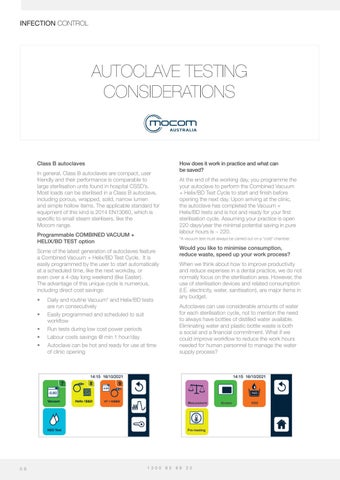INFECTION CONTROL
AUTOCLAVE TESTING CONSIDERATIONS
Class B autoclaves
How does it work in practice and what can be saved?
In general, Class B autoclaves are compact, user friendly and their performance is comparable to large sterilisation units found in hospital CSSD’s. Most loads can be sterilised in a Class B autoclave, including porous, wrapped, solid, narrow lumen and simple hollow items. The applicable standard for equipment of this kind is 2014 EN13060, which is specific to small steam sterilisers, like the Mocom range.
At the end of the working day, you programme the your autoclave to perform the Combined Vacuum + Helix/BD Test Cycle to start and finish before opening the next day. Upon arriving at the clinic, the autoclave has completed the Vacuum + Helix/BD tests and is hot and ready for your first sterilisation cycle. Assuming your practice is open 220 days/year the minimal potential saving in pure labour hours is ~ 220.
Programmable COMBINED VACUUM + HELIX/BD TEST option
*A vacuum test must always be carried out on a “cold” chamber.
Would you like to minimise consumption, reduce waste, speed up your work process?
Some of the latest generation of autoclaves feature a Combined Vacuum + Helix/BD Test Cycle. It is easily programmed by the user to start automatically at a scheduled time, like the next workday, or even over a 4-day long weekend (like Easter). The advantage of this unique cycle is numerous, including direct cost savings: • • • • •
5 8
When we think about how to improve productivity and reduce expenses in a dental practice, we do not normally focus on the sterilisation area. However, the use of sterilisation devices and related consumption (I.E. electricity, water, sanitisation), are major items in any budget.
Daily and routine Vacuum* and Helix/BD tests are run consecutively Easily programmed and scheduled to suit workflow Run tests during low cost power periods Labour costs savings @ min 1 hour/day Autoclave can be hot and ready for use at time of clinic opening
1 3 0 0
Autoclaves can use considerable amounts of water for each sterilisation cycle, not to mention the need to always have bottles of distilled water available. Eliminating water and plastic bottle waste is both a social and a financial commitment. What if we could improve workflow to reduce the work hours needed for human personnel to manage the water supply process?
6 5
8 8
2 2










